
This chapter covers:Why is Research Important?Approaches to ResearchAnalyzing FindingsEthicsFor more information, visit OpenStax College.
- Subject:
- Psychology
- Social Science
- Material Type:
- Module
- Date Added:
- 07/10/2017

This chapter covers:Why is Research Important?Approaches to ResearchAnalyzing FindingsEthicsFor more information, visit OpenStax College.
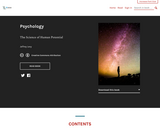
The first chapter provides an overview of the textbook and reviews the history of psychology and its methodology. Psychology is described as a science studying how hereditary (nature) and experiential (nurture) variables interact to influence the thoughts, feelings, and behavior of individuals. The remainder of the text will be organized in sections entitled “Mostly Nature” (Biological Psychology; Sensation & Perception; Motivation & Emotion), “Mostly Nurture” (Direct Learning; Indirect Learning (i.e., observational learning and language); Cognition), and “Nature/Nurture” (Human Development; Personality; Social Psychology; Maladaptive Behavior; Professional Psychology and Human Potential).
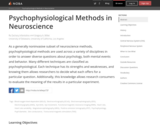
As a generally noninvasive subset of neuroscience methods, psychophysiological methods are used across a variety of disciplines in order to answer diverse questions about psychology, both mental events and behavior. Many different techniques are classified as psychophysiological. Each technique has its strengths and weaknesses, and knowing them allows researchers to decide what each offers for a particular question. Additionally, this knowledge allows research consumers to evaluate the meaning of the results in a particular experiment.
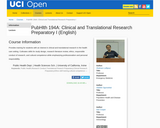
Provides training for students with an interest in clinical and translational research in the health care setting. Cultivates skills for study design, research literature review, ethics, responsible conduct of research, and cultural competence while emphasizing professionalism and personal responsibility.
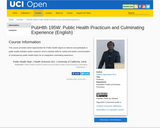
This course prrovides direct opportunities for Public Health majors to observe and participate in public health activities and/or research; and to cultivate skills for verbal and written communication of contemporary public health topics for an integrative culminating experience.
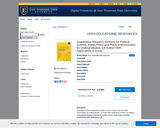
Quantitative Research Methods for Political Science, Public Policy and Public Administration for Undergraduates: 1st Edition With Applications in Excel is an adaption of Quantitative Research Methods for Political Science, Public Policy and Public Administration (With Applications in R). The focus of this book is on using quantitative research methods to test hypotheses and build theory in political science, public policy and public administration. This new version is designed specifically for undergraduate courses. It omits large portions of the original text that focused on calculus and linear algebra, expands and reorganizes the content on the software system by shifting to Excel and includes guided study questions at the end of each chapter.
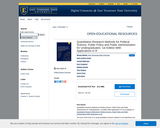
Quantitative Research Methods for Political Science, Public Policy and Public Administration for Undergraduates: 1st Edition With Applications in R is an adaption of Quantitative Research Methods for Political Science, Public Policy and Public Administration (With Applications in R). The focus of this book is on using quantitative research methods to test hypotheses and build theory in political science, public policy and public administration. This new version of the text omits large portions of the original text that focused on calculus and linear algebra, expands and reorganizes the content on the software system R and includes guided study questions at the end of each chapter.
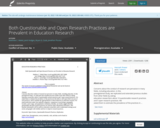
Discussions of how to improve research quality are predominant in a number of fields, including education. But how prevalent are the use of problematic practices and the improved practices meant to counter them? This baseline information will be a critical data source as education researchers seek to improve our research practices. In this preregistered study, we replicated and extended previous studies from other fields by asking education researchers about 10 questionable research practices and 5 open research practices. We asked them to estimate the prevalence of the practices in the field, self-report their own use of such practices, and estimate the appropriateness of these behaviors in education research. We made predictions under four umbrella categories: comparison to psychology, geographic location, career stage, and quantitative orientation. Broadly, our results suggest that both questionable and open research practices are part of the typical research practices of many educational researchers. Preregistration, code, and data can be found at https://osf.io/83mwk/.
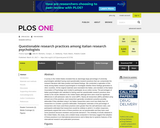
A survey in the United States revealed that an alarmingly large percentage of university psychologists admitted having used questionable research practices that can contaminate the research literature with false positive and biased findings. We conducted a replication of this study among Italian research psychologists to investigate whether these findings generalize to other countries. All the original materials were translated into Italian, and members of the Italian Association of Psychology were invited to participate via an online survey. The percentages of Italian psychologists who admitted to having used ten questionable research practices were similar to the results obtained in the United States although there were small but significant differences in self-admission rates for some QRPs. Nearly all researchers (88%) admitted using at least one of the practices, and researchers generally considered a practice possibly defensible if they admitted using it, but Italian researchers were much less likely than US researchers to consider a practice defensible. Participants’ estimates of the percentage of researchers who have used these practices were greater than the self-admission rates, and participants estimated that researchers would be unlikely to admit it. In written responses, participants argued that some of these practices are not questionable and they have used some practices because reviewers and journals demand it. The similarity of results obtained in the United States, this study, and a related study conducted in Germany suggest that adoption of these practices is an international phenomenon and is likely due to systemic features of the international research and publication processes.
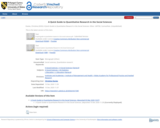
This resource is intended as an easy-to-use guide for anyone who needs some quick and simple advice on quantitative aspects of research in social sciences, covering subjects such as education, sociology, business, nursing. If you area qualitative researcher who needs to venture into the world of numbers, or a student instructed to undertake a quantitative research project despite a hatred for maths, then this booklet should be a real help.
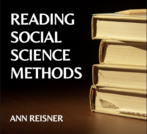
Science has great potential to benefit society, but this potential comes with risks as well. Directed at introductory level social science and humanities majors, this textbook teaches the rules and limits of social science methods. Reisner starts from the assumption that it is not necessary to be able to do research to read and judge the soundness of research publications. The chapters guide students through an explicit set of rules for reading research articles developed from three common research methods: content analysis, survey research, and experimental method.
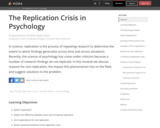
In science, replication is the process of repeating research to determine the extent to which findings generalize across time and across situations. Recently, the science of psychology has come under criticism because a number of research findings do not replicate. In this module we discuss reasons for non-replication, the impact this phenomenon has on the field, and suggest solutions to the problem.
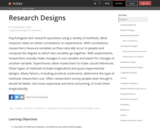
Psychologists test research questions using a variety of methods. Most research relies on either correlations or experiments. With correlations, researchers measure variables as they naturally occur in people and compute the degree to which two variables go together. With experiments, researchers actively make changes in one variable and watch for changes in another variable. Experiments allow researchers to make causal inferences. Other types of methods include longitudinal and quasi-experimental designs. Many factors, including practical constraints, determine the type of methods researchers use. Often researchers survey people even though it would be better, but more expensive and time consuming, to track them longitudinally.
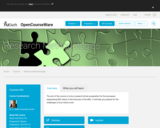
It is expected that Students who take part in this course have completed almost all courses of their MSc and are about to start on their Master Orientation project, their Literature Study or MSc thesis depending on their chosen MSC track.
It is of little value to take this course early, so please plan accordingly!
Course Contents The aim of the course is to be a research-driven preparation for the aerospace engineering MSc thesis in the final year of the MSc. It will help you prepare for the challenges of your thesis work.
The course will consist of 7 lectures and will be taught online using video lectures in periods 1, 2 and 3 and face-to-face using traditional lectures in period 4.
The lecture set up is as follows:
1. Research Design in MSc - Introduction to research, research framework
2. Research Methods - Stages of a project, Research objective, research questions, research strategy, research methods
3. Data Analysis - Quantitative & Qualitative methods
4. Validation & Verification - How to validate & verify your work?
5. Project Management & Peer review of draft Project plan - How to manage your project and your thesis progress. Project plan peer review
6. Planning - How to plan, expectations, Gannt Charts
7. Literature Review - How to carry out a scientific literature review? Differences between review and research
Please be advised that all lectures are also available via Blackboard for those following the online version. It is possible to do this course by distant learning, attendance in the 4th period, though highly appreciated, is not mandatory!
Study Goals At the end of the course the student will:
- be aware of the expectations of an MSc student
- be able to formulate a research question and research aim
- be able to set up a research plan for their MOP/Literature Study/MSc thesis
- be able to write a literature review based on the research plan with a view to select appropriate methodologies for their MOP/MSc thesis
Education Method (Online) Lectures, Assignments and voluntary Peer review of each others research plans and literature studies
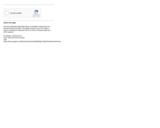
This book is based on two open-access textbooks: Bhattacherjee’s (2012) Social science research: Principles, methods, and practices and Blackstone’s (2012) Principles of sociological inquiry: Qualitative and quantitative methods. I first used Bhattacherjee’s book in a graduate-level criminal justice research methods course. I chose the book because it was an open educational resource that covered the major topics of my course. While I found the book adequate for my purposes, the business school perspective did not always fit with my criminal justice focus. I decided to rewrite the textbook for undergraduate and graduate students in my criminal justice research methods courses. As I researched other open- educational resources for teaching social science research methods, I found Blackstone’s book, which covered more of the social science and qualitative methods perspectives that I wanted to incorporate into my book.
As a result, this open-access textbook includes some content from both previous works along with my own additions based on my extensive experience and expertise in conducting qualitative and quantitative research in social science settings and in mentoring students through the research process. My Ph.D. is in Sociology, and I currently teach undergraduates and graduate students in a criminal justice program at Weber State University. Throughout my career, I have conducted and published the results of research projects using a variety of methods, including surveys, case studies, in-depth interviews, participant observation, content analysis, and secondary analysis of quantitative data. I have also mentored undergraduates in conducting community-based research projects using many of these same methods with the addition of focus groups and program evaluations.
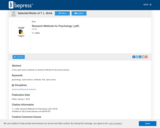
A free, open source, textbook on research methods for the social sciences.
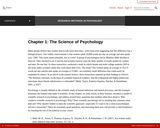
The present adaptation constitutes the second Canadian edition and was co-authored by Rajiv S. Jhangiani (Kwantlen Polytechnic University) and I-Chant A. Chiang (Quest University Canada) and is licensed under a Creative Commons Attribution-NonCommercial-ShareAlike 4.0 International License. Revisions include the following:
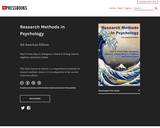
This third American edition is a comprehensive textbook for research methods classes. It is an adaptation of the second American edition.
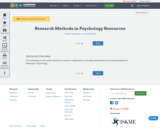
The following are discussion questions, research assignments, and slides presentations for teaching Research Methods in Psychology.
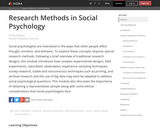
Social psychologists are interested in the ways that other people affect thought, emotion, and behavior. To explore these concepts requires special research methods. Following a brief overview of traditional research designs, this module introduces how complex experimental designs, field experiments, naturalistic observation, experience sampling techniques, survey research, subtle and nonconscious techniques such as priming, and archival research and the use of big data may each be adapted to address social psychological questions. This module also discusses the importance of obtaining a representative sample along with some ethical considerations that social psychologists face.